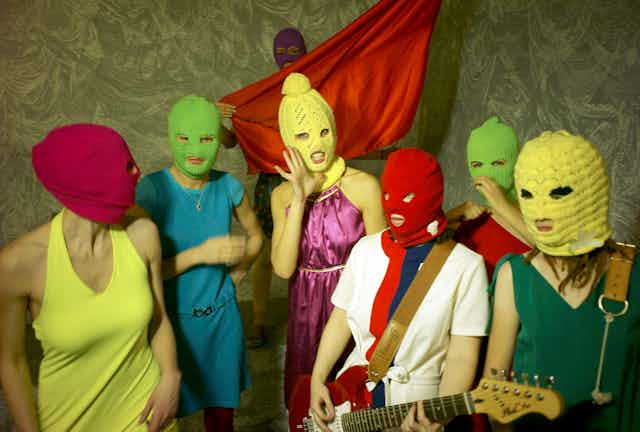It wasn’t long between spells in jail for two members of Russian punk band Pussy Riot. Maria Alyokhina and Nadezhda Tolokonnikova were briefly arrested at the Sochi Olympics, having only been released from a much lengthier term at the end of 2013.
The pair were arrested with two other group members while “just walking around” the city, outside of Putin’s officially sanctioned zone for protests at the Olympics. Cameras immediately swarmed them as they sang “Putin will teach you how to love the motherland.”
It is perhaps ironic that this has occurred at the Olympics because last time Alyokhina and Tolokonnikova were released under Vladimir Putin’s amnesty to prisoners, the pair declaimed the move as a pre-games publicity stunt. So what do these most recent skirmishes with police in Sochi mean in publicity terms?
As of late, these two members have been catapulted to the upper echelon of fame. Every performance and statement associated with the group’s identity, whether publicly authored by them or not, is documented by the papers, posted on Facebook, and chattered about endlessly on Twitter. This is because they are seen to represent the Russian backlash against corruption and repression, and are therefore championed.
Pussy Riot has a variable membership, and one that is also entirely approximate. This only adds fuel to the fire of media speculation.
The stunt that landed Alyokhina and Tolokonnikova in jail two years ago, a “punk prayer” performed by five masked members in Moscow’s Cathedral of Christ the Saviour on February 21 2012, unmasked the pair, and turned them into overnight celebrities.
And so two years later, on February 6 2014, Tolokonnikova and Alyokhina stepped onstage with Madonna for Amnesty International’s Bringing Human Rights Home concert at the Barclays Center. The duo’s US tour also included spots on Colbert, National Public Radio and press with The Times – all to campaign for prisoner’s rights. They didn’t however, visit actual prisoners.
Members of Pussy Riot actually view this rising celebrity status as potentially harmful to their artistic freedom. And some, including the third arrested member, Yekaterina Samutsevich, have accused Tolokonnikova’s husband, Pyotr Verzilov, of using their name for personal profit.
In an early interview Samutsevich spoke out against these ownership disputes:
The problem contradicts the idea behind our group. We are against commercialisation, and we don’t want Pussy Riot to become a brand … we are still a group with no commercial goal.
In publicity around their art, Pussy Riot’s brightly-coloured balaclavas have become an international symbol loaded with contradictory meanings.
For most Western audiences Pussy Riot evokes heroic 20th century tales of Eastern dissidents criticising an oppressive regime. This is perhaps a central reason for the level of publicity they have received. Tolokonnikova herself recently alluded to these older stereotypes in jest, reporting that she has received several offers from Hollywood studios eager to create a feature-length film, and that the movie would be “just like Star Wars”.
But joking aside, there are deep political stakes in the way these women are represented, especially considering that Pussy Riot is very much still an evolving public performance. Members’ discomfort with commodification is understandable, given their views on art, they see profiting from social activism as distorting their message.
The ideas Pussy Riot stand for in the news and in their own words cannot easily be mapped onto a grid depicting state vs society or easily boiled down into a Hollywood ending. The group has provided inspiration for a global outpouring of creativity, much of which speaks to their ostensibly less glamorous roles as public intellectuals.
Anonymity offers powerful leverage. In an open letter posted to Pussy Riot’s blog the day after the Brooklyn concert, six anonymous members put forth an ideological split with Tolokonnikova and Alyokhina:
The mixing of the rebel feminist punk image with the image of institutionalised defenders of prisoners’ rights is harmful for us as a collective … We cover our heads, because we oppose the very idea of using the female face as a trademark for promoting any sort of goods or services.
On February 11, Tolokonnikova and Alykohina denied the split and called the letter a fake on the basis that “Pussy Riot can be anyone … Pussy Riot can only grow.”
The guise prevents authorities from taking retaliatory actions in response to unmasked members’ human rights campaigning. Both the letter and the reply are part of a media performance that preserves anonymity — the mask — at the centre of Pussy Riot.
The fact remains that on February 18 2014 in the Russian town of Sochi, four members of the group were briefly arrested together, and six were attacked the following day. Two are known, the rest are masked, but all stand together against Putin, even if some think the group should stick more closely to its radical feminist agenda.
There could be eight members of Pussy Riot, or there could be thousands, indeed as many as oppose Putin’s regime.
AUTHOR UPDATE FEB 20: Six members of Pussy Riot were whipped by Cossack militia today. The group had started performing 21 miles from the site of the Winter Olympics in Sochi when they were attacked. The scene (see below) could have taken place in the 15th century when Cossack calvary once served the Tsar by enforcing order in an expanding Russian Empire. At Sochi, the guards are functioning as reinforcements for the Krasnodar regional units.

